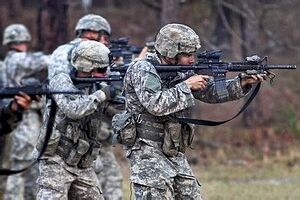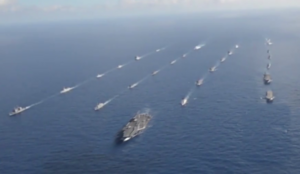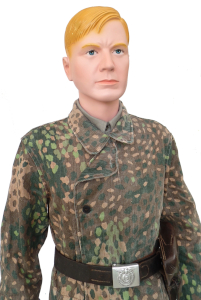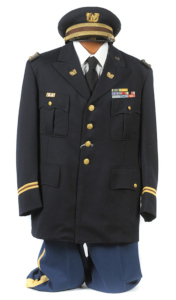Library:The Ice Military (Imperial Regime)
This article is about the Ice military circa 1414. It may not reflect the current military of the Ice States.
The Ice Military is currently run by General Lionel Burkes. It was originally known as the "Ice Liberation Front" when founded in 1380 to reestablish the Empire of Icelandia after a coup d'etat formed the regime known as the Secular Republic of Icelandia. It was led by General John Sotolo, who went on to become the founder and first Emperor of the Empire of The Ice States after its reestablishment. When The Empire got refounded, it was renamed to "The Ice Military" and became the official military of The Ice States. The Ice Military remains an important component of The Ice States, being a core part of the nation's security and government, and plays a significant role in national culture.
It is now led by General Lionel Burkes, who has grown activity in the military and established the separate "conscript" and "volunteer" titles available. He also grew the military by merging it with the law enforcement force. The Ice Military contains various divisions -- 1 - 200 are various divisions of the nation's security force, 200 - 500 are the nation's land force, 500 - 700 are the naval force, and 700 - 800 are the air force, while 1000 - 2000 are the reserves. In turn, each division has 25 units, ranging from 5 to 50 personnel each.
Each force, division, unit, etc. is headed by its own commander. There further exist various ranks within each force, division, unit, etc. Only those registered as "volunteers", rather than "conscripts", are eligible to receive promotions beyond "Corporal".
In total, The Ice Military has 1,711,200 personnel, of which 538,300 are active and 1,172,900 are reserves -- corresponding to 2.8%, 0.9%, and 1.9% of the total population of The Ice States respectively.
Leadership
The General of The Ice Military is General Lionel Burkes, who was appointed in 1410 by Emperor Sotolo II four years into his reign. The General maintains full authority over all sections components of the military, subject to the decrees of the Emperor and Klyprer. The Emperor or Klyprer maintains the authority to dismiss the General for any reason.
The General maintains a body of Colonels, the second most senior rank. Each Colonel is appointed to advise and assist the General, but the General still maintains authority over the Colonels. There are currently eight active Colonels of the Ice Military. Each force of the Ice Military is also commanded by a Force Commander, the other rank directly below the General.
All decisions to go to war or otherwise deploy in any situation outside of purely domestic deployment to deal with intranational security threats must be approved by both the Emperor and Klyprer, through the Divine Scribe. This restriction exists to prevent wasteful deployment of the Ice Military that would result in harm for future, more important deployments, and to prevent a traitorous General from intentionally or unintentionally deploying the military in a manner that would go against the interests of The Ice States.
History
The disgraced, cowardly Emperor Covitz was known for his sheer incompetence in his leadership of Icelandia, failing to do anything to maintain law and order. He effectively obstructed the duties of all government leaders other than the Divine Scribe, so that the military was rendered incapacitated, law enforcement services could not be deployed, and the Order of Klyprer failed to be promoted. Anarchy and chaos was rife. This culminated in the overthrow of Covitz in a coup d'etat by Paul Cardona and his cronies, the so-called Freedom Army, in 1379, resulting in the establishment of the Secular Republic of Icelandia (SRI).

An underground resistance movement formed against the SRI, plotting to overthrow the government and reestablish The Empire. It was led and organised by John Sotolo. By 1380, this had become a formal army, the Ice Liberation Front (ILF). At first, the ILF was unsuccessful, and SRI forces subjugated the ILF, until Sotolo showed his military genius at the Battle of Ormont in October 1383, a massive battle taking several days that ended with a clear victory by the ILF, with the SRI suffering heavy losses. At December 1385, the Battle of Stonegrad cemented the ILF's victory, with the ILF executing Cardona and establishing the Liberated Theocracy of Icelandia.
The Liberated Theocracy was intended to be a short-term government as a new government was established. This was eventually established, with the Liberated Theocracy being dissolved and the Empire of The Ice States being formally founded with the assent of Klyprer, expressed through Divine Scribe Theodore Lowney. The ILF was established as the formal military of The Ice States and renamed The Ice Military.
Upon establishment of The Empire of The Ice States, General Miles Nehme was established as the first General. He did an excellent job in building the military, resulting in his long-time service as General for 12 years before he resigned in 1401 to serve as Duke of Magecastle, and is responsible for the establishment of much of the structure of the modern Ice Military. He was succeeded by General Tom Rorabacher, who served a mediocre term until one of his so-called "training exercises" extraordinarily failed, resulting in the death of much of the military and the wasting of much of the military's funds. He was thus fired as General and got replaced by General Burkes, who was then a Colonel and had served as Commander of both the Navy and the Land Force, in 1410. Our of anger and jealousy, Rorabacher attempted to assassinate Burkes, and promptly got forced into slavery, resulting in his death.
In 1412, a decision was made to merge the quickly growing and recovering Ice Military with the nation's law enforcement services. This merge resulted in the strengthening of both forces, with law enforcement now being a force of the Ice Military, and has seen significant reduction of domestic crime rates. In 1413, the military was placed in a state of emergency for the first time, meaning that the General can activate all reserves at any time and each force should be fully ready for deployment, in light of a blockade on The Ice States by various nations, such as the Ordenite Reich and Holy Marsh. This escalated into an ongoing full-scale war with the Federal Republic of Czaslyudian Peoples in 1414.
Security Force
The Security Force is, in effect, the nation's law enforcement force. It contains 200 divisions, and 214,000 total personnel, which range from land, sea, and water-based deployments. It regularly deploys throughout The Ice States to arrest, execute, or punish criminals, and to directly take action against crime whenever it is occuring. Several divisions also deploy internationally to help in policing civilian populations or to guard embassies. It is currently led by Force Commander Alex Bowan, who was appointed by General Burkes in 1411 following the death of Bowan's predecessor in combat.
The Security Force plays a pivotal role in action against domestic crime, and is one of the most well-trained and largest forces of the Ice Military. It also contains the most resources of any division of the Ice Military, which are primarily land-based weapons such as both short-distance and long-distance rifles, electroshock and other incapacitating weapons, and chemical weapons for mass use against crowds; but also sea-based weapons to combat escapes and other illegal sea-based smuggling and transportation; and air-based weapons such as missiles primarily but rarely used against very large crowds.
The Security Force was originally known as the Ice Police Agency, which was the police force of the Empire of the Ice States upon its establishment in 1389. In 1412, it was merged with the military of the Ice States and became the Security Force, as is the status quo today, an idea originally proposed by General Burkes.
| Divisions | Scope of duty | Total personnel |
|---|---|---|
| 1 - 24 | Air-based domestic security | 4,800 |
| 25-49 | Foreign policing | 18,400 |
| 50-99 | Sea policing | 49,800 |
| 100-194 | Land policing | 143,000 |
| 195-200 | Public guard | 1,000 |
Land force
The Land Force is by far the most significant active-duty force of the Ice Military. It contains the most personnel of any active force of the Ice Military, with 248,500 total personnel, and 300 divisions. It is trained for participation in foreign conflicts and wars on land, being trained to be adept warriors in all harsh and advantageous situations, utilising everything around them to their advantage and being skilled in use of all weapons for every situation. The Land Force is trained to win land battles and work alongside other forces to ensure Ice victory in conflicts in which the Empire participates. The Land Force is led by Force Commander Jeff Cowles, who has led the force since 1392.
The Land Force is not only the largest, most important force of the Ice Military, but also the most well-equipped component of the Ice Military, with every soldier having at least one long- and short- range rifle each, and each unit possessing at least one tank and one large-scale cannon, among other things depending on importance and rank of these units. New, sophisticated weapons are routinely designed and distributed to the Land Force, with on average there being one new design each one or two months. Since 1413, those at or above a "Lieutenant" rank in the Land Force also receive the "Ice-J13" rifle, which contains a novel "Aim-Aid" mechanism that, when turned on, automatically detects and aims at non-Ice personnel near the otherwise aim so as to avoid both missed targetting and friendly fire.
The Land Force is one of the most thrilling parts of the military that one can participate in. Despite not having yet participated in a large-scale war, the daily routine of a soldier of the Land Force ranges from simple target shooting to large-scale caving and night hunting in some of the most stunning locations. Land Force soldiers regularly face their fears to complete adventures that can take several days or even weeks and ultimately come out successfully, often gaining a new promotion.
The Land Force, along with the Air Force, is one of the only divisions of The Ice Military to use Artificial Intelligence in place of soldiers. Most cannons and other artillery are deployed by Artificial Intelligence so as to efficiently shoort without risk of human error. The Ice-B14 rifle is also currently in development, which effectively forms a unison of many rifles that use technology similar to J13 to automatically fire at enemy targets without needing any sort of human input, thus being able to efficiently fire easier without requiring any personnel.
| Divisions | Scope of duty | Total personnel |
|---|---|---|
| 1 - 49 | Air-based domestic security | 4,800 |
| 50-99 | Sea policing | 49,800 |
| 100-299 | War deployment | 177,500 |
The naval force of The Ice States is the force of the Ice Military trained specifically for deployment in water-based environments. It is particularly large, maintaining 200 divisions and 56,200 personnel. Unlike the Land Force, Naval Force soldiers are much more well-specialised, with different divisions being trained for different circumstances. The Naval Force also does not use artificially intelligent technology in place of soldiers, but the Force remains technologically sophisticated. For example, Naval Force submarines are each equipped with sensors to detect marine activity above the ship, and nearly all warships are equipped with cannons and missiles. Other weaponry contained by nearly all warships are firebombing missiles, naval mines, and mine detectors. Some warships -- usually only lead warships -- also contain chemical weapon missiles which cause incapacitation and eventually death to where they are deployed. The Naval Force is currently led by Force Commander Delbert Lykken, who has led it since 1412.
A Naval Force fleet is made up of one division, and when deployed, one unit forms one warship. Thus, a fleet contains 25 warships, headed by a lead warship of the 25 -- the lead warship at a fleet will be the warship of the Division Commander. Units, in the Naval Force, are slightly smaller than in the other forces, on average only having ten personnel each; this is not the smallest average unit, however, as the Air Force maintains even smaller units.
Much of the Naval Force is currently deployed surrounding the North, East, and South borders of The Ice States to prevent incursions into water territory owned by the Empire with the ongoing blockade. However, the Naval Force is currently not yet directly fighting the blockade on The Ice States as negotiations are currently underway with The Golden Throne to secure foreign aid from the blockade and the withdrawal of some participants.
| Divisions | Scope of duty | Total personnel |
|---|---|---|
| 1 - 29 | Border security | 7,500 |
| 30-79 | Freshwater Divisions | 14,500 |
| 80-119 | Submarine Divisions | 80,000 |
| 120-199 | Sea-surface Divisions | 26,200 |
Air Force
The Air Force of The Ice States is the smallest force of the Ice Military, both in terms of personnel and divisions, only having 19,600 personnel in 100 divisions. However, the Air Force is the most automated military force by far. AI- and remotely-controlled aircraft make up the vast majority of the Air Force, which are designed to engage in aerial bombing -- in particular firebombing -- of ships, cities, and land, and chemical attack of population and military centres, including ships. The Air Force contains the second-largest equipment stockpile, with a large stock of over 600k total missiles, for use both against land and in sea and against other aircraft. Most air-to-air combat is performed by manual aircraft and units, as opposed to AI fighters. The Air Force is led by Force Commander Howard Paswaters as of 1410.
Personnel in the Air Force are primarily trained to manage and operate manually-operated aircraft, primarily in air-to-air combat. Most training, both by manual and remote driving divisions, thus takes the form of air-to-air fake combat against unmanned disposable aircraft, as well as driving manually- and remotely-operated aircraft.
Similar to the Naval Force, one unit in the Air Force makes one ship -- or aircraft. Thus, Naval Force units are very small, with on average each unit only containing 8 personnel -- the smallest average units of the Ice Military.
| Divisions | Scope of duty | Total personnel |
|---|---|---|
| 1 - 9 | Border security | 2,100 |
| 10-49 | Remote air warfare | 6,600 |
| 50-99 | Manual air warfare | 10,900 |
Reserves
The reserves of the Ice Military make up the largest component, with 1,172,900 total personnel and 1,000 divisions. The reserves are notable as the only section of the Ice Military not headed by its own Commander, instead being commanded directly by the General. The reserves may be activated by the Emperor upon receiving Klyprer's assent, and usually at recommendation of the General. However, as the Ice Military remains in a state of emergency as of now, currently they may be activated at any time by the General if assent is received from Klyprer.
As the active forces of the Ice Military, the reserves are organised in divisions, which are in turn organised into 25 units. The average unit of the reserves contains 47 personnel, which is more than in any other section of the Ice Military. The Reservists are trained to be able to deploy at any time for any force, in land, air, and water environments. Reservists, in effect, work part-time, only being required to attend a training session lasting for three hours each month, but being required to serve full-time if activated.
The reserves, when deployed, participate in a variety of duties, such as manual air-to-air combat, shooting in battle, ship driving, water battle, and both long-range and short-range missile deployment. Training primarily focuses on water-based warfare and land warfare, but is intended to ensure that reservists can deploy in any situation when needed.
Unlike the other forces of the Ice Military, the Reserves do not maintain any specialised divisions -- divisions in the reserves only exist for organisational purposes, as the reserves are largely non-specialised.
Ranks
The Ice Military maintains a total of 24 different ranks -- of which one active soldier possesses four at a time, in the Military, Force, Division, and Unit. Further, each member of the military maintains either "conscript" or "volunteer" status. To transition to "volunteer" from "conscript", one has to continue to serve in the military beyond what is required for the purposes of conscription; eg, serving in the reserves after the conscription reserve term concludes, or serving in the active military during the conscription reserve term instead of serving in the reserves. One can also change back to "conscript" if originally conscripted and still serving during his conscription term.
Ranks in each Force are generally the same as those of the overall military -- except the head of a Force is ranked as "Commander", as opposed to "General", and the authority of a Force Commander is subject to the General.
List of military ranks _
- General
The commander of the entire Ice Military. The General -- currently Lionel Burkes -- maintains full control of the military, subject to the Emperor and Klyprer.
- Colonel
A Colonel is, in effect, advisor and deputy to the General. Colonels engage in organising missions on behalf of the General, and may impose a non-binding veto on General decisions, but are still subject to full authority of the General. There are currently eight colonels.
- Major
A major is, in effect, a long-time senior member of the military who has shown himself to be capable of leading, organising, and adeptly participating in combat. Majors are able to lead missions of their own with approval of the General, and take over training also with the General's approval.
- Lieutenant
Lieutenants are generally promising members of the military who have served for around one or two years, and have demonstrated skilled leadership and adroitness in combat, but have not yet advanced to become a Major. Most Lieutenants also act as Division Commanders.
- Sergeant
A sergant is no longer a "new member" of the military, having consistently trained and shown skill and leadership for about a year, but not yet shown the leadership necessary to advance to Lieutenant rank -- however, most Sergeants quickly advance to become Lieutenants. Most Sergeants also serve as Unit Commanders.
- Corporal
A private advances to become a corporal once he proves a degree of experience in the military, and has shown himseflf to be skilled enough significantly contribute to a military conflict, but is still a "newcomer".
- Private
The lowest rank of the military. When one joins the military, he is automatically assigned to be a Private, where immediate training is intended to allow privates to promptly transition to become a Corporal within a few months.
List of unit and division ranks _
- Commander
The commander of the unit/division. Each Commander's authority is fully subject to his superiors, but commanders still are responsible for the acts of their division/unit.
- Colonel
As a Military or Force Colonel, a Unit/Division Colonel is, in effect, advisor and deputy to the Commander, organising missions on behalf of the Commander, and imposing a non-binding veto on General decisions, but still being subject to full authority of the Commander and his superiors.
- Lieutenant
Lieutenants are generally promising members of the unit/division who have served for around one year, and have demonstrated skilled leadership and adroitness in combat, but have not yet advanced to become a Colonel.
- Corporal
A private advances to become a corporal once he has proven a degree of experience in the unit/division, and has shown himself to be skilled enough significantly contribute to a military conflict, but is still a "newcomer".
- Private
The lowest rank of the unit/division, to which one is automatically assigned upon joining the unit/division.
Conscription
When a man reaches 17 years of age, they are required to enlist to an active force of the military for at least three years. Most conscripts choose to join the Land Force and Naval Force, whilst few choose to go to the Air Force -- partly due to the lesser need for personnel in the AF. There are currently 103,700 conscripts in active service, and 384,300 in reserve service.
Like all other military personnel, conscripts are automatically assigned as a "Private" and given "conscript" status. Those assigned with "conscript" status cannot be promoted beyond "Corporal" rank in any Force/Unit/Division etc. To change to "volunteer" status, one must serve in the military beyond what is required for conscription status, eg serving in the reserves after the conscription reserve term concludes, or serving in the active military during the conscription reserve term instead of serving in the reserves. Should one take an oath to serve at least one year of extra service, they can also be transitioned to "volunteer", but are severely penalised if they fail to do so barring force majeure. This system is designed to ensure that high-ranking personnel remain moralised, as opposed to only serving out of requirement, and as an incentive for continued military membership.
Once a conscript finishes three years of active service, they transition to join the reserves for ten years. However, they may still be activated by the General, especially with the state of emergency in which the Ice Military remains as of today.
The modern conscription system was originally established during the Liberated Theocracy era by King Sotolo -- now known as Emperor Sotolo I. It was later amended to bring the age of conscription from 20 to 17 by General Nehme in 1400 so as to improve both quality and quantity of service in the Ice Military.
Military Culture
The military maintains much special culture so as to make it a more fun experience to participate in. It shares similar branding to the Ice States' civilian government, such as the same motto and flag. However, it also has its own military anthem -- "Warship and Ice" -- which was written by General Burkes and then-Private Santino Enciso -- who was promoted to Lieutenant in part for his writing of the song -- in 1412. The military regularly participates in parades throughout the nation, annually on the 7th of June -- the day after Klyprer first saw the vision prompting him to create the world. During these parades, soldiers dress in formal uniform and walk a long route throughout the nation starting in Stonegrad and ending at Logow at the north-east in Ormont.
Unlike in other nations where conscription is viewed as a chore, the age of turning 17 and being conscripted is widely celebrated in The Ice States, where often conscripts would dress in formal military uniform for their birthdays in the morning and then travel to the military conscription site to choose a force and division scope to join and receive all equipment needed for a fruitful military career.
Promotions always occur in a formal ceremony each month, which all active and reserve military members are required to attend barring force majeure, and wherein promoted soldiers swear an oath publicly before receiving a new badge and certificate of promotion. Such ceremonies are also held upon the emergency appointment of a new Commander or General.




